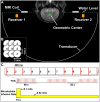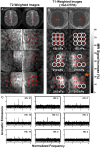Controlled ultrasound-induced blood-brain barrier disruption using passive acoustic emissions monitoring
- PMID: 23029240
- PMCID: PMC3454363
- DOI: 10.1371/journal.pone.0045783
Controlled ultrasound-induced blood-brain barrier disruption using passive acoustic emissions monitoring
Abstract
The ability of ultrasonically-induced oscillations of circulating microbubbles to permeabilize vascular barriers such as the blood-brain barrier (BBB) holds great promise for noninvasive targeted drug delivery. A major issue has been a lack of control over the procedure to ensure both safe and effective treatment. Here, we evaluated the use of passively-recorded acoustic emissions as a means to achieve this control. An acoustic emissions monitoring system was constructed and integrated into a clinical transcranial MRI-guided focused ultrasound system. Recordings were analyzed using a spectroscopic method that isolates the acoustic emissions caused by the microbubbles during sonication. This analysis characterized and quantified harmonic oscillations that occur when the BBB is disrupted, and broadband emissions that occur when tissue damage occurs. After validating the system's performance in pilot studies that explored a wide range of exposure levels, the measurements were used to control the ultrasound exposure level during transcranial sonications at 104 volumes over 22 weekly sessions in four macaques. We found that increasing the exposure level until a large harmonic emissions signal was observed was an effective means to ensure BBB disruption without broadband emissions. We had a success rate of 96% in inducing BBB disruption as measured by in contrast-enhanced MRI, and we detected broadband emissions in less than 0.2% of the applied bursts. The magnitude of the harmonic emissions signals was significantly (P<0.001) larger for sonications where BBB disruption was detected, and it correlated with BBB permeabilization as indicated by the magnitude of the MRI signal enhancement after MRI contrast administration (R(2) = 0.78). Overall, the results indicate that harmonic emissions can be a used to control focused ultrasound-induced BBB disruption. These results are promising for clinical translation of this technology.
Conflict of interest statement
Figures









References
-
- Pardridge WM (2007) Drug targeting to the brain. Pharm Res 24: 1733–1744. - PubMed
-
- Kroll RA, Neuwelt EA (1998) Outwitting the blood-brain barrier for therapeutic purposes: osmotic opening and other means. Neurosurgery 42: 1083–1099; discussion 1099–1100. - PubMed
-
- Doolittle ND, Miner ME, Hall WA, Siegal T, Jerome E, et al. (2000) Safety and efficacy of a multicenter study using intraarterial chemotherapy in conjunction with osmotic opening of the blood-brain barrier for the treatment of patients with malignant brain tumors. Cancer 88: 637–647. - PubMed
-
- Pardridge WM (2007) Blood-brain barrier delivery. Drug Discov Today 12: 54–61. - PubMed
Publication types
MeSH terms
Substances
Grants and funding
LinkOut - more resources
Full Text Sources
Other Literature Sources

